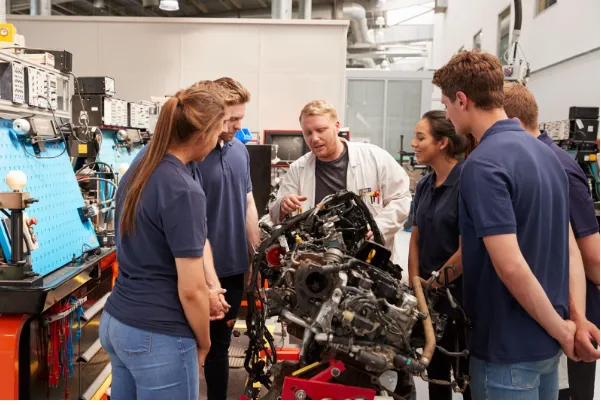When automotive enthusiasts discuss legendary Japanese engineering innovations, Honda’s Variable Valve Timing and Lift Electronic Control (VTEC) system inevitably takes center stage. This revolutionary technology fundamentally changed performance engine design, allowing relatively small-displacement engines to deliver impressive power while maintaining excellent fuel efficiency and reliability. Decades after its introduction, VTEC remains a cornerstone of Honda’s engineering philosophy and continues to inspire admiration among performance enthusiasts worldwide.
Also Read: How to Clean Silver Coins: A Step-by-Step Guide
The Genesis of VTEC: Solving an Engineering Puzzle
Conventional engine design has traditionally faced a fundamental compromise: valve timing and lift profiles that produce optimal low-end torque and smooth operation generally limit high-RPM performance. Conversely, aggressive cam profiles that enable high-RPM power typically result in rough idling, poor fuel economy, and reduced low-end torque. Before VTEC, engineers had to choose a middle ground that sacrificed potential at both ends of the performance spectrum.
Honda’s breakthrough came in the late 1980s when engineer Ikuo Kajitani developed a system that could effectively provide two different cam profiles in a single engine. The first VTEC system debuted in the 1989 Honda Integra XSi in Japan, featuring the 1.6-liter B16A engine. This compact four-cylinder produced an astonishing 160 horsepower—achieving 100 horsepower per liter, a figure that was revolutionary for a naturally aspirated production engine at that time.
How VTEC Works: Engineering Elegance
The beauty of VTEC lies in its elegant mechanical solution to a complex problem. In a VTEC-equipped engine, each intake and exhaust valve is operated by two different cam profiles on the same camshaft. At lower RPMs, the valves follow a conservative profile optimized for fuel efficiency and torque. When the engine reaches a predetermined RPM threshold (typically between 4,500 and 6,000 RPM depending on the specific VTEC implementation), hydraulic pressure activates locking pins that connect the valves to a third, high-lift rocker arm following a more aggressive cam profile.
This transition—often accompanied by the distinctive “VTEC kicked in” sound that enthusiasts celebrate—effectively transforms the engine’s personality. The more aggressive valve timing and lift allow for improved cylinder filling at high RPMs, resulting in a significant power increase exactly when a performance driver wants it: in the upper reaches of the engine’s rev range.
The JDM Honda engine for sale market specifically prizes certain VTEC-equipped motors for their unique performance characteristics and potential. Models like the B16B, B18C Type R, K20A, and F20C represent different evolutions of the VTEC philosophy, each with distinct power delivery and modification potential.
Beyond the Original: VTEC Variations
Honda continued to refine VTEC technology through several evolutionary stages:
- VTEC-E (Economy): Focused on fuel efficiency, this system deactivated one intake valve at low RPMs to create swirl in the combustion chamber, improving fuel atomization and combustion efficiency. At higher RPMs, both valves would operate normally. The D15Z1 and D16Y5 engines exemplify this economical approach.
- 3-Stage VTEC: Featured in engines like the SOHC D15B, this complex system used three distinct cam profiles to optimize performance across a broader RPM range, with separate transitions for economy, mid-range, and high-RPM operation.
- i-VTEC (Intelligent VTEC): Introduced in the early 2000s with the K-series engines, i-VTEC combined traditional VTEC with Variable Timing Control (VTC). This addition allowed for adjustable camshaft phasing throughout the RPM range, further optimizing both power and efficiency.
- AVTEC (Advanced VTEC): Honda’s latest evolution adds continuously variable timing adjustment for even more precise control over valve events. This technology represents the ultimate refinement of the VTEC concept.
Each iteration maintained the fundamental principle while adding sophistication to address specific performance objectives, demonstrating Honda’s commitment to continuous improvement.
The JDM Performance Legacy
Japanese Domestic Market Honda engines often featured more aggressive VTEC implementations than their counterparts in other markets. The Type R variants, in particular, received special attention with hand-assembled engines featuring strengthened internals, higher compression ratios, and more aggressive cam profiles. These JDM engines became legendary among enthusiasts for their exceptional performance potential and characteristic high-RPM power delivery.
Notable examples include:
- B16B: Found in the EK9 Civic Type R, this 1.6-liter engine produced 185 horsepower at 8,200 RPM—an astonishing 116 horsepower per liter without forced induction.
- B18C Type R: The heart of the DC2 Integra Type R, this engine featured hand-polished ports, a high compression ratio, and produced 200 horsepower while revving to 8,400 RPM.
- K20A Type R: Powering the DC5 Integra Type R and FD2 Civic Type R, this engine combined i-VTEC technology with Type R engineering to deliver exceptional performance across the RPM range.
These engines weren’t just powerful for their displacement—they delivered their power with a distinctive character that emphasized responsiveness and a rewarding driving experience. The rush of power as VTEC engaged created an emotional connection between driver and machine that turbocharged engines often couldn’t match.
Tuning and Modification Potential
The robust design of VTEC engines has made them particularly popular platforms for performance modifications. From mild upgrades like intake and exhaust improvements to comprehensive builds featuring increased displacement, forced induction, or complete engine swaps, Honda’s engines offer exceptional potential for customization.
The modular design of many Honda components allows for relatively straightforward mixing of parts from different engine families, creating hybrid combinations that weren’t available from the factory. This “mix and match” potential has spawned entire communities dedicated to optimizing these engines for various performance objectives.
Modern engine management systems have further expanded these possibilities, allowing tuners to precisely optimize VTEC engagement points, fuel delivery, and ignition timing for specific applications. This adaptability has ensured that Honda’s VTEC engines remain relevant in the performance landscape decades after their introduction.
Environmental Performance Without Compromise
Perhaps most impressively, Honda achieved this performance breakthrough while maintaining excellent emissions control and fuel efficiency. The precise control over valve events allowed VTEC engines to optimize combustion across operating conditions, reducing emissions without sacrificing performance—an achievement that was well ahead of its time.
This balance between performance and efficiency reflected Honda’s engineering philosophy of maximizing performance without waste. Rather than simply increasing displacement or adding forced induction, Honda’s approach emphasized extracting maximum efficiency from every aspect of engine operation.
A Lasting Influence
VTEC’s impact extends far beyond Honda’s own products. The technology effectively demonstrated the viability of variable valve timing and lift systems, inspiring similar developments across the automotive industry. Today, virtually every major manufacturer employs some form of variable valve timing in their engines, applying the fundamental principle that Honda pioneered.
For enthusiasts, VTEC represents more than just a clever engineering solution—it symbolizes an approach to performance that values intelligence and efficiency over brute force. The distinctive character of a high-revving VTEC engine continues to offer an engaging driving experience that connects driver to machine in an increasingly digitized automotive landscape.
As the industry transitions toward electrification, the principles behind VTEC—maximizing efficiency without compromising performance—remain relevant. Honda’s engineering legacy continues to influence how performance is defined and delivered, maintaining the spirit of innovation that has characterized the brand throughout its history.



